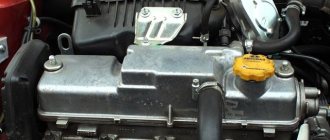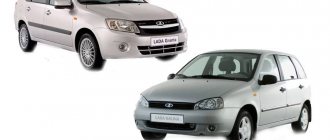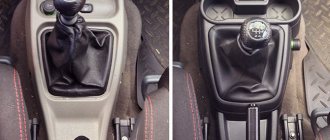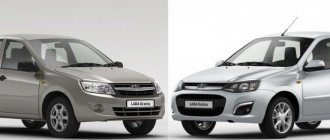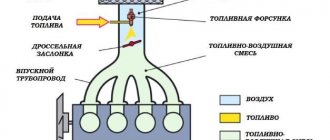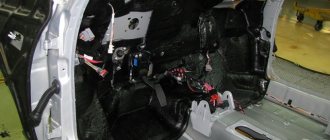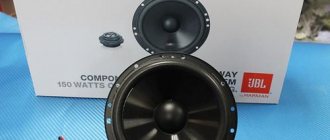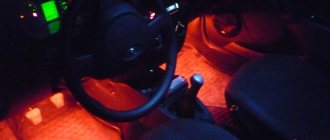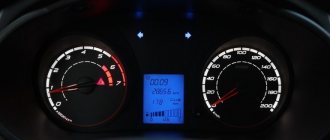At AvtoVAZ, Kalina 2 does not install boots for the holes under the tie rods, but there is a demand for them, so there are quite a lot of offers on the market for this accessory.
The main purpose of these anthers is to protect the engine compartment from dust and dirt, but the effectiveness of the accessory is not as high as many people think, and there are also a lot of disadvantages.
Advantages of the boot holes for tie rods:
- As long as the boot is intact, it actually prevents dust and dirt from entering the engine compartment.
Next are the cons:
- Most of the models on the market are of poor quality, so they break down quite quickly;
- If the boot is made of hard material, it is more durable, but there is a high probability that the steering rods will suffer from the hard material;
- To install the anthers, you must either cut them (initially damaging them) or unscrew the rods;
- Engine cooling deteriorates as the air flow under the hood is distributed slightly differently.
As can be seen from the comparison, there are indeed more disadvantages from such anthers than advantages, although some car owners have positive experience installing these plugs.
Do you need steering rod plugs for Lada Granta, Kalina?
Dirt plugs for the steering rod opening are designed to protect the engine and engine compartment from dust, dirt and winter salt entering through openings in the engine compartment. They are installed in special technological holes in the front wheel arches. For some unknown reason, AVTOVAZ did not install such steering rod plugs on the Lada Kalina, Grant and Priora, or maybe they are of no use?
Purpose
: Steering rod plugs protect the engine compartment from dirt while driving through puddles and off-road.
Installation
: insert the grooves on the boot into the edges of the body.
vendor code
: rubber 1118-3414088 and 1118-3414089, or silicone red 1118-3414088/89SBA-SPORT.
Price
: about 600 rubles per pair.
To find out whether it is worth installing plugs to protect the engine compartment from dirt or not, we invite you to participate in the survey and leave feedback on this modification of the car.
Share on social networks:
Found an error? Select it and press Ctrl+Enter..
Source
Lada Granta MAGMA › Logbook › Installing rubber steering rod plugs.
The other day I installed a very useful gadget on my swallow. Rubber dirt-proof plugs for steering linkage openings from Kalina. They seem to be popularly called “ears.” I bought it at the local auto parts market. To install, you must remove the tie rod ends. True, people mostly cut them, so as not to bother with pressing out the tips, and attach them with self-tapping screws through special ears directly to the body. I absolutely do not want to make holes in my body with self-tapping screws to avoid further corrosion in these places. Moreover, the place is very susceptible to moisture and dirt. And cut “ears” without fastening them with self-tapping screws will fall off very quickly. In short, the other day I decided to install them correctly. I jacked it up, removed the wheel, squeezed and pulled out the cotter pin, and unscrewed the steering pin nut with a 19mm wrench. Next, I pressed out the finger using a steering puller. The puller must be inserted very carefully under the boot, the main thing is not to tear it. Also, you should not press it too hard, otherwise some of the lubricant will come out of it. We begin to squeeze the puller until the finger pops out of the cone. If, when the puller nut is tightened as much as possible, the finger does not want to come out of the seat, you need to make a pointed blow with a hammer on the puller from below. Measure the force of the blow; you cannot hit it hard with a heavy hammer. Suspension components may be damaged. A light blow is enough and the finger will pop out. If this does not happen, again tighten the puller nut as much as possible, thereby increasing the tension, and again make a gentle, targeted blow. Repeat all of the above until the steering tip pin pops out of its seat. This is all described for a specific type of puller that I had on hand (as in the photo). For other types, the principle of operation may differ.
Next, a “surprise” awaited me. These same “ears” come in two types: 1. The kind I bought - from ordinary viburnum. Unfortunately, I don’t know the original numbers. Shown in the first photo. The fundamental difference is that the traction slot is located close to the edge of the elastic. With our grant, without modifications, only the standard equipment will be installed. For standard and luxury, look for the second type. Well, or as a last resort, if you don’t find it, then I will describe how they need to be modified with a “file” so that they fit properly and do not fly out of the seat.
2. The kind you should have bought - most likely from Viburnum - sport. I don't know the numbers either. Shown in the second photo. The fundamental difference is that the slot for traction is located closer to the center.
The point is, the Norms and Luxes are equipped with a standard suspension from Kalina-Sport. The front castor has been changed and a new steering rack with fewer revolutions has been installed. Thanks to all this, the steering rods are located in the openings almost in the middle, whereas in a regular Kalina and in the Grant Standard configuration they are located close to the edge of the opening. And if you install “ears” number 1 on Granta Norma or Lux, they will simply fly off or instantly tear.
In order not to rush around looking for “ears” number 2, I modified the rubber bands I bought and installed them temporarily as is. In the photo I marked where it is necessary to trim and by how much.
Next, I installed them in the openings and assembled everything in reverse order. They sat very tightly. After trimming there is no excess tension on the rubber. I've been using them for two weeks now and they haven't fallen out or torn yet and they look good. The photo shows their current condition.
For now I’ll travel with them, but when I come across ears with a middle slot, I’ll buy and install them without hesitation. Still, after trimming, small gaps remained in the engine compartment. And dirt still flies through them in small quantities. So consider the type of plugs specifically for your car, and buy the right ones.
I hope someone will find useful information. So far I’ve discovered that there are these plugs that fit the norm perfectly, and I’ve scoured dozens of pages on various forums.
Installation of steering rod plugs for Lada Granta
At AvtoVAZ, Kalina 2 does not install boots for the holes under the tie rods, but there is a demand for them, so there are quite a lot of offers on the market for this accessory. The main purpose of these anthers is to protect the engine compartment from dust and dirt, but the effectiveness of the accessory is not as high as many people think, and there are also a lot of disadvantages.
Advantages of the boot holes for tie rods:
- As long as the boot is intact, it actually prevents dust and dirt from entering the engine compartment.
Next are the cons:
- Most of the models on the market are of poor quality, so they break down quite quickly;
- If the boot is made of hard material, it is more durable, but there is a high probability that the steering rods will suffer from the hard material;
- To install the anthers, you must either cut them (initially damaging them) or unscrew the rods;
- Engine cooling deteriorates as the air flow under the hood is distributed slightly differently.
As can be seen from the comparison, there are indeed more disadvantages from such anthers than advantages, although some car owners have positive experience installing these plugs.
A little theory: front suspension design
Before attempting to fix any problem, there is a tendency to look at the blueprints or repair manual. It is known that the VAZ-2192 parts catalog contains the following object:
This is what the steering rack looks like in the drawing
Whether the knock will remain in the steering rack of Kalina-2 depends on the following: how accurately element “14” is adjusted. The adjusting nut, marked “14”, looks almost invisible here. But first impressions are deceiving. In the catalog, by the way, the element is called “Stop Nut”.
It is important to know that the thrust nut has external threads. And it spins clockwise. And the words “tighten the rack” mean screwing in the specified nut, and nothing more.
Now let's move on to practice and see what the node in question looks like in reality:
Steering rod Lada Granta
Replacing the Lada Granta steering rod
Replacement of the steering rod on a Lada Granta car is carried out in the event of its failure, when play in the ball pin increases, as well as to replace the rubber protective boot or when carrying out other work in which the presence of traction will interfere. Prepare a standard set of tools, a ball pin remover and perform the following sequence of actions:
· Remove the battery by disconnecting the terminals.
· Use pliers to remove the locking pin and, having unscrewed the pin nut, use a puller to disconnect it from the rotating arm of the telescopic stand.
Replacing steering tips on Lada Kalina
The tie rod end is an important element of the car, the function of which is to transmit translational energy from one steering unit to another, provided that the angle between them can change. The tip is made in the form of a hinge - a device with moving elements. As a rule, the number of these components in different models may differ - much depends on the type and design features of the steering. In particular, the number of rods ranges from four to six.
Device Features
Tie rod ends consist of several main components - a casing with an axle shaft, a ball pin (it has a special thread cut into it), a Teflon liner (the task is to ensure full movement and fixation of the ball pin), a boot (protects the unit from dust and dirt), a cover on body (also protects the unit from various debris). In addition, the design of the tips includes a special elastic ring (designed to hold the cover on the finger), the nut of the finger itself and the spring of the cover (it is used to secure the edge to the body).
Please note that there is no play in the new tip, because the pressure of the ball pin to the liner is very tight. Over time, the liner wears out and the finger has extra room to maneuver. In turn, the appearance of backlash significantly impairs the controllability of the car.
Basic steering problems
As we have already mentioned, problems with steering tips (as, in fact, with other elements of the steering mechanism) are very critical. A serious malfunction can lead to loss of control over the vehicle and, as a result, an accident. In such a situation, it is necessary to clearly know and promptly recognize the main signs of failure of a particular unit. These include:
— the appearance of strange knocking noises and steering areas;
— strong vibrations of the steering wheel;
— vertical play of the steering wheel (this indicates a breakdown of the ball joint or hub bearings);
— horizontal play of the steering wheel is evidence of failure of the steering tip;
— spontaneous change in the trajectory of movement.
All of the problems listed above require a detailed check of the control system. In doing so, pay special attention to the following points:
— quality of drawing of the adjusting coupling clamp;
— peculiarities of movement of the steering tips (the permissible distance should be no more than 1.5 mm). This is easy to check. Ask your partner to turn the steering wheel and check the play on the ball joints yourself. If there is knocking or play, the tip must be replaced. Please note that the backlash may not appear the first time - it is advisable to carry out several checks;
— serviceability of the protective housing of the ball joint. If there is damage or cracks, it is advisable to replace the cover.
Changing the steering tip on Lada Kalina
If you have come to the conclusion that a steering tip is needed or you suspect that it is faulty, proceed as follows:
- Prepare the tool for work. You will need a jack, a wheel wrench (you should definitely have it in the trunk), a pair of open-end wrenches (at “17” and at “19”), a torque wrench (for tightening with the necessary force), pliers, a hammer and a pry bar. If you manage to get a puller, then this is only a plus.
- Lightly unscrew the mounting nuts on the wheel and lift the side of the car where you plan to replace it.
- Tighten the wheel and treat all threaded elements with penetrating lubricant (pay special attention to the tie bolt and pin).
- Turn the steering wheel all the way. If you are working on the right side, then turn it to the right, and if on the left, then, accordingly, to the left.
- Unscrew the tightening bolt slightly (make a few turns).
- Straighten the cotter pin and use pliers to remove it.
- Use an open-end or socket wrench and unscrew the nut.
- If you can’t find the puller, then take out the pry bar and insert its “tip” between the tip and the swing arm. This is where the most important thing begins. Apply pressure on the pry bar as if you were walking to raise the tip slightly. If you cannot achieve success in this way, start tapping the rotary lever with a hammer (be sure to do this in the place where the finger is installed). Usually 3-4 blows are enough to knock the tip out of its home.
- Grab the tip and lift it up.
- Unscrew the assembly from the other side, directly from the steering rod. Be careful - rotation should be done in a clockwise direction.
- Record or remember how many turns you made before the tip was completely removed. Otherwise, wheel alignment problems may occur after assembly. If you remember the number of revolutions, you can easily assemble the unit into place. On Kalina it turns out somewhere around 20-24 revolutions (but the readings, of course, can be different).
- Take the tip you need, install it and screw it in counterclockwise (strictly observe the required number of turns).
- Return the fixing bolt to its place.
- The fastening nut of the tip (which tightens the assembly with the swing arm) must be pulled with a torque of 27-33 N*m. But most often, experts recommend doing the work with a slightly larger torque.
- Reinstall the locking pin and bend it around the edges.
- Put everything back in its place.
- If necessary, perform similar work on another wheel.
Which tie rods to choose
When choosing spare parts, you should decide whether to install factory or analog parts. Often, parts installed from the factory last much longer than those we install as replacements. However, sometimes even original parts last less than expected.
- Left steering tip 11180-3414057-00 (VAZINTERSERVIS /OAT/) price from 450 rub.
- Right steering wheel end 11180-3414056-00 (VAZINTERSERVIS /OAT/) price from 450 rub.
Good quality and very popular tips from TRACK
- Left tip TR70-107 price from 400 rub.
- Right handpiece TR70-108 price from 400 rub.
If it is not possible to purchase original factory tips, you can choose analogues:
- HOFER HF 812002 price from 700 RUR set of 2 pieces
- BELMAG BM1118-3414056/57 price from 800 RUR set
You can also immediately purchase tips from the company TRACK TRST-110 in a set of 2 pieces, price from 850 rubles per set
Grantanswer #2
Many Lada Granta car owners sooner or later have various questions about the car. Experienced owners have fewer such questions, while beginners have more. Our “Grant Answer” section has been prepared just to answer your questions.
If you have questions that you would like answered, you can ask them in the comments.
What is the fuel consumption on a Grant with an automatic transmission, with a quiet ride?
A clear answer to this question cannot be given, since the driving style and the conditions in which the car moves differ greatly from driver to driver and from city to city. The manufacturer, represented by AvtoVAZ, regulates consumption at 7.6 liters per 100 km in the combined cycle, which is approximately one liter higher than that of its manual counterparts. However, owners of a Lada Granta with an automatic transmission confirm the consumption is about 1.5-2 liters more in the city, relative to a manual, and about 0.5 liters more on the highway. If you are interested in a more detailed answer regarding fuel consumption, read our article: Fuel consumption on the Lada Granta.
When cold the car starts and immediately stalls, on the second try everything is fine. What is the problem?
A recurring feature of Lada Granta cars. Official representatives of the plant do not give a clear answer to this question, citing the possible uniqueness of each problem and advise visiting a car service center for diagnostics. Most often, diagnostics show the serviceability of all systems, and the result of this feature is not very high-quality gasoline. As a rule, changing the fuel or gas station helps solve the problem. Otherwise, a more thorough diagnosis will be required. In any case, this issue should be approached individually and there is no general solution to the issue at the moment.
Is it worth installing steering rod plugs?
My personal experience in operating cars from the Volzhsky plant says that installing rubber plugs, which are sold in car dealerships or car markets, is a little more than useless. The whole reason is that the material for these same plugs is extremely unstable, as a result of which after just a couple of weeks or a month the protective petals come off and you again have a gaping hole. The most effective method of protecting tie rod openings is to use canvas and other homemade rag plugs. In many cities, such devices are sold at car markets or in small auto shops, and they will often offer to install them there. This type of protection will be the most durable and effective. However, again based on my experience, I want to say that no plugs will help protect against dirt and make the engine compartment clean. In any case, after some time there will be dust and dirt under the hood again. The most effective way to keep the engine compartment clean is to clean it regularly. It is enough to simply wipe all the units with a damp cloth several times a year and wash them in a car wash once every year or two.
Installation of anthers for steering rod holes on Lada Kalina 2
The first option is to cut the plug and install it in place. To be sure, you can glue the cut area with glue, but this is not necessary.
The second option is to unscrew the steering rod, put a plug on it, and then install it in place.
Before installation After installation
We are waiting for your feedback on this modification of Kalina 2. We have previously written about how to protect the engine crankcase.
The article used photographs from user Lenkinkot095 of the drive2.ru website.
Many Lada Granta car owners sooner or later have various questions about the car. Experienced owners have fewer such questions, while beginners have more. Our “Grant Answer” section has been prepared just to answer your questions.
If you have questions that you would like answered, you can ask them in the comments or on our forum in the appropriate topic.
What is the fuel consumption on a Grant with an automatic transmission, with a quiet ride?
A clear answer to this question cannot be given, since the driving style and the conditions in which the car moves differ greatly from driver to driver and from city to city. The manufacturer, represented by AvtoVAZ, regulates consumption at 7.6 liters per 100 km in the combined cycle, which is approximately one liter higher than that of its manual counterparts. However, owners of a Lada Granta with an automatic transmission confirm the consumption is about 1.5-2 liters more in the city, relative to a manual, and about 0.5 liters more on the highway. If you are interested in a more detailed answer regarding fuel consumption, read our article: Fuel consumption on the Lada Granta.
When cold the car starts and immediately stalls, on the second try everything is fine. What is the problem?
A recurring feature of Lada Granta cars. Official representatives of the plant do not give a clear answer to this question, citing the possible uniqueness of each problem and advise visiting a car service center for diagnostics. Most often, diagnostics show the serviceability of all systems, and the result of this feature is not very high-quality gasoline. As a rule, changing the fuel or gas station helps solve the problem. Otherwise, a more thorough diagnosis will be required. In any case, this issue should be approached individually and there is no general solution to the issue at the moment.
Is it worth installing steering rod plugs?
My personal experience in operating cars from the Volzhsky plant says that installing rubber plugs, which are sold in car dealerships or car markets, is a little more than useless. The whole reason is that the material for these same plugs is extremely unstable, as a result of which after just a couple of weeks or a month the protective petals come off and you again have a gaping hole. The most effective method of protecting tie rod openings is to use canvas and other homemade rag plugs. In many cities, such devices are sold at car markets or in small auto shops, and they will often offer to install them there. This type of protection will be the most durable and effective. However, again based on my experience, I want to say that no plugs will help protect against dirt and make the engine compartment clean. In any case, after some time there will be dust and dirt under the hood again. The most effective way to keep the engine compartment clean is to clean it regularly. It is enough to simply wipe all the units with a damp cloth several times a year and wash them in a car wash once every year or two.
Please tell me, is the entire chassis of the Lada Granta the same as the Lada Kalina-2?
Yes, the chassis of the Lada Grant is identical to that of the Lada Kalina-2. The latter has been completely unified with the Lada Granta since the model’s release. The castor of the front struts is 2.45 degrees, the camber of the rear wheels is -1 degree. The shock absorbers and struts are also identical.
The car pulls to the right, the wheel alignment does not help, what should I do?
There are several reasons for a car to pull to one side: incorrect wheel alignment angles, damage to the suspension, poor quality wheels. Visiting a center to install wheels does not always guarantee correct installation. Smaller services often do not have a special program for installing Granta wheels and display them according to the Lada Kalina program, which is fundamentally wrong. At the same time, the master must check the serviceability of the suspension, which could have been damaged if it fell into a hole or hit any other obstacle. Poorly balanced and “crooked” wheels or a difference in tire pressure may also be the cause. It is worth considering all these factors.
Red silicone dirt-proof plugs for the steering rod opening for Lada Granta, Kalina, Kalina 2
CHOOSE SECURE PAYMENTS After payment you will receive an electronic cash receipt
Tube for modifying the seals of the sliding windows of Lada Granta, Kalina, Kalina 2
with 19% discount
Silent bolts for door locks Lada Kalina, Kalina 2, Granta
with 19% discount
USB charger 2 slots for Lada Priora, Granta, Kalina 2
with 11% discount
Set of seals for lockers and fender liners for Lada Granta, Kalina 2, datsun
with 11% discount
Rubber battery mat
with 19% discount
Hood seal Lada Granta, Kalina 2
with 10% discount
Tune-Auto protective cover for the rear bumper of Lada Kalina, Kalina 2 station wagon
with 9% discount
Set of universal fan nozzles on a nut
with 19% discount
Pay for goods by credit card, using QIWI, Yandex.Money or WebMoney and save on your purchase from 4%, avoiding postal and bank commissions
This product was chosen by 99 customers
The plugs are designed for installation in steering linkage openings to protect the engine and engine compartment of the vehicle from dust, winter salt and dirt entering through these openings. Silicone plugs do not harden in the cold.
Weight, kg: 0.5 Dimensions, cm: 24 x 19 x 5 Volume, m3: 0.00228
Dirt plugs for the steering rod opening for Lada Kalina, Granta
Set of dirt-proof plugs for steering linkage openings for LADA Granta, Kalina 1 and 2 cars.
The price is for a set (left, right).
Set of dirt-proof plugs for steering linkage openings for Lada Granta, Kalina 1 and 2 cars.
The price is for a set (left, right).
These plugs are designed to protect the engine and engine compartment of the car from dust, winter salt and dirt entering the body through openings.
| Automobile: | Granta, Kalina 1, Kalina 2 |
Reviews
Delivery of goods is carried out throughout Russia and the CIS:
1. Russian Post (from 350 rubles and above)
Delivery to all regions of the Russian Federation and CIS countries
2. Transport Companies (from 400 rubles and above)
Delivery throughout Russia and the Republic of Kazakhstan
- TK Energy (nrg-tk.ru)
- TC Business Lines (dellin.ru)
- TC SDEK (www.cdek.ru)
- TK PEK (pecom.ru)
- TK KIT (tk-kit.ru)
3. Pickup
The order can be picked up at the office at Tolyatti, 40 Let Pobedy 38, TD “Malachite”, 1st floor.
Product delivery options
Note! Below are the shipping methods available specifically for this product. Payment options may vary depending on the shipping method. Detailed information can be found on the “Delivery and Payment” page.
Parcel by Russian Post
Available payment methods:
- Cash on delivery (payment upon receipt)
- Using cards Sberbank, VTB, Post Bank, Tinkoff
- Yandex money
- QIWI
- ROBOKASSA
Shipping throughout Russia. Delivery time is from 5 to 12 days.
Parcel by Russian Post 1st class
Available payment methods:
- Cash on delivery (payment upon receipt)
- Using cards Sberbank, VTB, Post Bank, Tinkoff
- Yandex money
- QIWI
- ROBOKASSA
Shipping throughout Russia. Delivery time is from 2 to 5 days. More expensive than regular delivery by Russian Post, approximately 50%. Parcel weight up to 2.5 kg
Express Parcel EMS
Available payment methods:
- Cash on delivery (payment upon receipt)
- Using cards Sberbank, VTB, Post Bank, Tinkoff
- Yandex money
- QIWI
- ROBOKASSA
Shipping throughout Russia. Delivery time is from 3 to 7 days. More expensive than regular delivery by Russian Post, approximately 100%.
Transport companies
Available payment methods:
- Using cards Sberbank, VTB, Post Bank, Tinkoff
- Yandex money
- QIWI
- ROBOKASSA
Delivery is possible to any locality where there is a representative office of the transport company. Delivery time is from 2 to 10 days. Sending large parcels is approximately 50% more profitable than by Russian Post.
Reviews
Delivery of goods is carried out throughout Russia and the CIS:
1. Russian Post (from 350 rubles and above)
Delivery to all regions of the Russian Federation and CIS countries
2. Transport Companies (from 400 rubles and above)
Delivery throughout Russia and the Republic of Kazakhstan
- TK Energy (nrg-tk.ru)
- TC Business Lines (dellin.ru)
- TC SDEK (www.cdek.ru)
- TK PEK (pecom.ru)
- TK KIT (tk-kit.ru)
3. Pickup
The order can be picked up at the office at Tolyatti, 40 Let Pobedy 38, TD “Malachite”, 1st floor.
Payment can be made in the following ways:
1. Payment to a Sberbank card
You can pay using the SBERBANK-Online application and other Bank applications.
After placing an order, making payment, do not indicate comments , we ourselves will understand by the amount of the order and the name of the sender. After receiving the funds, the status of your order will be changed to paid until 17.00 of the current day, or from 9.00 of the next Moscow time.
2. By bank card
Automatic acceptance of payments using MIR Bank cards, VISA International, Mastercard.
You can also pay with credit cards with a grace period.
To select payment for goods using a bank card, on the corresponding page you must click the “Pay for order by bank card” button.
2. QIWI wallet 89272115207
3. Cash on delivery of Russian Post (commission from 4%)
IMPORTANT! When sending by cash on delivery, RUSSIAN POST will take a commission for providing the cash on delivery service of 150-300 rubles, and the delivery cost also increases due to the evaluation of the goods.
Cash on delivery delivery is possible only within Russia.
ATTENTION! When choosing cash on delivery, the delivery cost is paid in advance before dispatch, for the product itself upon receipt.
The amount of the order by cash on delivery should not exceed 5000 rubles. Also, painted parts, goods made to order, covers, upholstery, door inserts, EVA mats, steering wheels, etc. are not sent by cash on delivery. (minimum 50% prepayment).
Be sure to save the payment receipt or a screenshot of the transfer.
The best guarantee of order fulfillment and quality is the feedback from our customers.
Reviews about our work can be read in our VKontakte group https://vk.com/topic-136384247_36675422?offset=180
- home
- About Us
- Catalog
- Shipping and payment
- Reviews
- News and Promotions
- Personal Area
Disassembling the steering mechanism
We disassemble the steering mechanism when repairing it. Remove the steering mechanism (see “Removing the steering mechanism”). Remove the steering gear boot (see “Replacing the steering gear boot”).
Remove the steering rod support. We insert the bit into the groove of the crankcase pipe mounting nut.
We unscrew the nut, striking the beard (right-hand thread)…
...and remove the crankcase pipe.
Use a screwdriver to press out the two clamps of the bushing located inside the pipe...
...and remove the bushing.
Remove the two rubber rings from the bushing (arrows indicate the bushing clamps).
If it is necessary to replace the nut, use pliers to remove the locking rings... ...and remove the locking ring... Remove the pipe securing nut.
Remove the rubber plug from the rack stop adjusting nut. Using a scraper, remove the jammed metal in the locking areas of the stop adjusting nut.
Using a special 24mm wrench with an external octagonal head, unscrew the stop nut.
We take out the stop spring. Using a screwdriver...
...remove the O-ring.
By hitting the crankcase against a wooden block, we knock out the rack stop. Using a screwdriver...
...remove the liner from the stop. A rubber ring is installed in the groove of the stop.
Remove the rubber ring from the crankcase that seals the hole for the steering mechanism on the front panel.
Remove the boot from the gear shaft. Use a 6mm hexagon to unscrew the two screws (shown by arrows)…
...and remove the crankcase cover.
Remove the separator with the thrust bearing rollers.
Remove the sealing ring of the cover.
We remove the rack from the crankcase.
We press out the gear shaft by holding the shaft in a vice with soft metal jaw linings and pressing the crankcase upward with the mounting blade.
We remove the gear shaft with bearing from the crankcase. We pry it off with a screwdriver...
...and remove the bushing retaining ring.
We take out the gear shaft bushing assembled with the support plate.
If it is necessary to replace the needle bearing, use a drill with a diameter of 4 mm to drill two diametrically located holes in the crankcase so that they extend to the end of the outer ring of the needle bearing. Through the drilled holes, using a rod of the appropriate diameter, we knock out the outer ring of the bearing from the crankcase.
Using a puller, we press the ball bearing of the gear shaft with the inner ring of the roller thrust bearing.
Use a puller to press the inner ring of the needle bearing off the shaft.
Using a screwdriver, pry and remove the gear shaft oil seal from the crankcase cover. If the outer race of the roller thrust bearing needs to be replaced...
... use a scraper to remove the extruded metal in four places and take out the ring. We generously lubricate the bearings, rack and gear teeth, and the plastic rack bushing with Fiol-1 lubricant. We assemble the steering mechanism in the reverse order. We press the outer ring of the needle bearing into the crankcase using a mandrel of suitable diameter. To seal holes in the crankcase, you can use “fast steel” or “cold welding”. We press the gear shaft with the ball bearing into the crankcase using a piece of pipe of a suitable diameter or a high head, applying force to the outer ring of the bearing. You can press the gear shaft into the crankcase, resting the outer ring of the bearing on the jaws of a vice. Then we put the crankcase on the bearing...
...and press the crankcase with light blows of a hammer through a wooden block.
We press the gear shaft seal into the cover through a mandrel or head flush with the end of the cover. We insert the rack into the steering gear housing. We install the pipe.
After tightening the pipe fastening nut, tighten the nut.
Scheme for monitoring the gap in the engagement of the rack and pinion shaft:
1 – dial indicator; 2 – indicator mounting bracket; 3 – nut; 4 – sealing ring; 5 – steering gear housing; 6 – needle bearing; 7 – gear shaft; 8 – bushing; 9 – crankcase cover; 10 – rack; 11 – liner; 12 – rack stop; 13 – indicator leg; 14 – spring
We rotate the gear shaft so that the flat on it is located on the right side. We move the rack so that the steering rod support mounted on the rack is located in the middle of the pipe groove. We insert the rack stop, the stop spring and tighten the stop nut. It is recommended to replace the stop nut with a new one. We adjust the gap in the engagement of the gear with the rack. To do this, set the rail in the middle position and block it from moving. Insert the leg of the dial indicator into the hole of the adjusting nut of the stop until the tip of the leg touches the stop of the rack. The diameter of the tip of the indicator leg must be at least 3.5 mm...
...so that the leg rests against the end surface 1 of the stop, and does not fall into its hole 2 (for clarity, shown on the dismantled stop). We apply a torque of 15 N m (1.5 kgf m) to the gear shaft, while the gear pushes the rack and stop. Based on the indicator readings, we determine the amount of movement of the stop, which corresponds to the actual value of the gap in the engagement. If it exceeds 0.05 mm, tighten the adjusting nut, achieving the specified amount of movement of the stop. After this, having unlocked the rack, we check the ease of rotation of the drive gear throughout the entire range of travel of the rack.
How to install steering rod plugs on a Lada GrantaLink to main publication
- How to remove the front heater radiator UAZ Bukhanka
Disassembling the Lada Granta steering mechanism
Tool:
- Ratchet wrench
- 13 mm head
- Open-end wrench 13 mm
- Open-end wrench 14 mm
- Open-end wrench 24 mm
- 15 mm straight box spanner
- Jack or ditch lift
- Wheel key
- Large flat screwdriver
- Sliding pliers
- Side cutters
- Bench vice with soft jaws
- Special key with octagonal head 17 mm
- Special key with octagonal head 24 mm
- Mounting blade
- Knife
- Two-legged puller
- A special puller or electric drill with a hammer
- Circlip Pliers
- Kerner
- Torque wrench
Source
